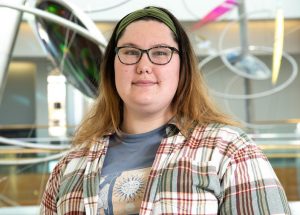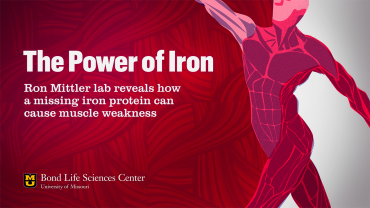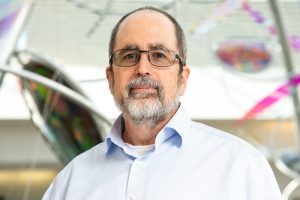Reactive Oxygen Species Metabolism
Ron Mittler Lab
Research Interests
In recent years, the Mittler lab has begun to address the common pathways and genes that regulate ROS and iron metabolism in plant and animal cells, and to focus on rapid responses at the transcriptome and metabolome level that accompany abiotic stress responses. One of the most interesting findings that emerged from these studies was the discovery that the 2Fe-2S protein NAF-1 plays a key role in regulating cellular proliferation and tolerance to oxidative stress in human epithelial breast cancer cells and tumors.
ABOUT THE LAB
Three main projects that have occurred in his laboratory include:
The ROS Wave and Ultrafast Omics Responses to Abiotic Stress
Systemic signaling pathways enable multicellular organisms to prepare all of their tissues and cells to an upcoming challenge that may initially only be sensed by a few local cells. They are activated in plants in response to different stimuli including mechanical injury, pathogen infection, and abiotic stresses. Key to the mobilization of systemic signals in higher plants are cell-to-cell communication events that have thus far been mostly unstudied. His recent discovery of systemically propagating reactive oxygen species (ROS) waves in plants has unraveled a new and exciting cell-to-cell communication pathway that, together with calcium and electric signals, could provide a working model to how plant cells transmit long-distance signals via cell-to-cell communication mechanisms. His study of rapid systemic signaling has also focused my attention on rapid local responses to stress and on the cross talk between ROS, ABA and stomatal responses. These have brought him to formulate another hypothesis on plant systemic responses called the leaf autonomous response pathway. Supported by IOS-1353886 and IOS-1063287.
Stress Combination
Abiotic stress is the primary cause of crop loss worldwide, with losses in the US estimated at 14-19 billion dollars each year. While abiotic stress is routinely studied in plants by applying a single stress condition such as drought, salinity or heat, this type of analysis does not reflect the conditions that occur in the field or in nature in which crops and plants are subjected to a combination of different stresses (e.g., drought and heat). Because abiotic stress combinations had the outmost devastating economical and sociological impacts on the US, with losses of 48.4 and 61.6 billion dollars in 1980 and 1988 respectively, and because these extreme weather events are likely to increase in frequency due to global warming, the development of transgenic crops with improved tolerance to abiotic stress combinations is a highly important goal that would provide a promising avenue to reduce yield losses and secure food supply for our growing population. His initial studies into abiotic stress combinations in plants demonstrated that the response of plants to a combination of two different stresses is unique and cannot be directly extrapolated from the response of plants to each of the different stresses applied individually. He has also identified several key regulatory proteins required for the acclimation of plants to stress combinations. He is currently working towards the identification of important regulatory networks that mediate the acclimation of plants to abiotic stress combinations, as well as towards the development of plants and crops with enhanced tolerance to stress combination. Supported by IOS-0820188.
Regulation of Cell Survival and Death Pathways by Fe-S Proteins
Maintaining iron and reactive oxygen species (ROS) homeostasis is essential for cellular proliferation, stress responses, and the regulation of cell survival and death pathways in plant and animal cells. The recent discovery of a novel group of Fe-S containing proteins with a redox-sensitive labile 2Fe-2S cluster in plant and animal cells (NEET proteins), provides one of the first links between the regulation of iron levels and ROS homeostasis in cells. His studies show that the function of NEET proteins is both ancient and essential for proper iron/ROS/Fe-S mobilization in cells. They propose that NEET proteins use their redox-active labile clusters to sense the levels of ROS/redox in cells, and depending on these levels they either promote cellular proliferation, or trigger the activation of apoptosis and autophagy. They recently discovered that the degree of lability of the NEET’s 2Fe-2S clusters and their overall protein levels in cells are crucial for making this decision, and have shown using different mutants and other molecular tools that cancer cells that accumulate high levels of wild type NEET proteins (but not mutant NEET proteins with a high cluster stability) are protected from oxidative stress and can proliferate faster. Their findings establish a key role for NEET protein overexpression in promoting the tumorigenicity of breast cancer cells. Furthermore, they provide a mechanistic foundation for the role of NEET overexpression in multiple cancer types, including breast, prostate, gastric, cervical, liver, and laryngeal cancers. He is currently working toward developing different therapies (drugs, peptides), as well as different delivery methods (nanoparticles) that will target the stability of the 2Fe-2S cluster of NEET proteins, thereby alter the redox/ROS levels of cells. These would be applicable not only for the treatment of different cancers that rely on high expression levels of NEET proteins for their proliferation, but also for the treatment of diabetes and certain neurodegenerative diseases that have also been linked to NEET protein overexpression. Supported by MCB-1613462 and IOS-1557787; proposals pending with NIH.
LAB MEMBERS






In the News

Dec. 11, 2024
A call for resilience
Plant scientists recommend concerted approach to global food security Adobe Stock image By Roger Meissen | Bond Life Sciences Center Climate change presents increasing dangers to crops, and plant scientists across the world recognize rapid changes are needed to prepare for its threats. That’s the message a coalition of plant and agriculture researchers detailed recently in Trends in Plant Science. Organized by Michigan State University’s Plant Resilience Institute (PRI), their paper spelled out how farmers, scientists and policymakers must…

May 22, 2024
The power of iron
One University of Missouri researcher’s latest discovery, published this week in Proceedings of the National Academy of Sciences, revealed how a muscle cell’s mitochondria fail to generate enough energy for skeletal muscles due to one iron–sulfur protein. This understanding could one day help lead to treatments for diseases like Duchenne muscular dystrophy — the most common type of muscular dystrophy in children — and muscle deterioration associated with aging.

Dec. 10, 2023
Bond LSC researchers recognized among most cited scientists of 2023
Bond LSC principal investigators Bing Yang (left) and Ron Mittler were once again recognized on the list of Highly Cited Researchers. | photos by Roger Meissen, Bond LSC By Roger Meissen | Bond LSC Discoveries in research come with time, so the incremental accumulation of knowledge toward breakthroughs is fundamental to science and the future. While many contribute to this understanding, a few scientists consistently produce research that others note more often in their own experiments. Two University of Missouri Bond Life Sciences Center researchers once again landed on that list of most…
